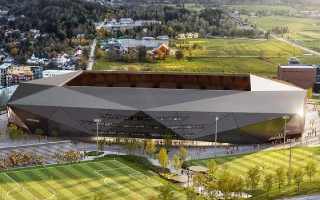Arctic Arena
| Capacity | 10 000 |
|---|---|
| Country | Norway |
| City | Bodø |
| Clubs | FK Bodø/Glimt |
| Category | Design awaiting implementation |
| Cost | NOK 1 B ($99.4 M) |
| Construction | 2025–2027 |
| Design | Nordic Office of Architecture |
Advertisement
Arctic Arena – design description
What does the Arctic Arena project look like in brief?
The extraordinary sporting achievements of FK Bodø/Glimt in recent years have made the team a phenomenon not only on a national scale but also in Europe – especially considering that this is a club from a town of just over 40,000 inhabitants, located north of the Arctic Circle.
These successes have opened the way for infrastructure development, particularly as the current Aspmyra Stadium barely meets the requirements for European competitions. At the end of 2024, the club held a competition in which the design for a new stadium at a different location was selected.
The modern Arctic Arena is planned to hold 10,000 spectators, with a distinctive dark, elegant facade featuring triangular forms reminiscent of a diamond. The entire design draws inspiration from the Arctic climate and Nordic architecture.
If everything goes according to plan, construction could begin in autumn 2025, with completion expected by mid-2027. The cost of building the stadium is estimated at one billion Norwegian kroner.
Who are FK Bodø/Glimt?
FK Bodø/Glimt is a football club founded in 1916 in Bodø – a town of just over 40,000 inhabitants in northern Norway, above the Arctic Circle. The club achieved its first domestic successes in the 1970s and again at the turn of the 20th and 21st centuries.
However, the most successful period began after the team was promoted to the Eliteserien in 2017. In 2019, the team finished as runners-up in Norway, and a year later became national champions. Subsequent league titles were also won in 2021, 2023, and 2024.
At the same time, the club achieved very good results in European competitions. In 2022, the team reached the quarter-finals of the UEFA Europa Conference League, and in 2025 the semi-finals of the UEFA Europa League. In August 2025, the team qualified for the UEFA Champions League for the first time in its history.
Where does FK Bodø/Glimt currently play?
FK Bodø/Glimt plays its home matches at Aspmyra Stadium. The stadium was originally built between 1965 and 1966, and after renovations in 1999–2001, the athletics track was removed. Modernizations carried out in 2022 increased the capacity to over 8,000 spectators and brought the stadium up to the requirements of European competitions, although it still falls short of higher standards.
When were the first plans for a new stadium for FK Bodø/Glimt made?
The first proposals for building a new stadium in Bodø date back to 2008 and were connected to Norway and Sweden’s joint bid to host Euro 2016. The stadium was planned to have a capacity of 30,000–35,000, which would be reduced to 10,000–15,000 after the tournament.
The new stadium in Bodø was intended to be the only venue representing Northern Norway as part of the bid – which ultimately never materialized, leaving the stadium plans unrealized.
Further plans appeared after the club’s promotion to Eliteserien in 2017. Thanks to the team’s success, the project became increasingly realistic, and a new stadium vision for FK Bodø/Glimt was presented in September 2021.
When was the Arctic Arena project created?
That concept was eventually abandoned, and in 2024 the club launched a design-and-build contest for the new stadium. Three companies entered the bidding process: Consto, Econordland, and Hent.
The competition was decided at the end of 2024, with the winning bid submitted by a consortium led by Consto. The company worked in cooperation with Leonhard Nilsen og Sønner (LNS) and Norconsult, while the architectural design was prepared by Nordic Office of Architecture in collaboration with Arup and ADC Design Studio. The project was given the working name Arctic Arena.
What does the Arctic Arena concept include?
The plan foresees the construction of a 10,000-seat, football-specific stadium. From the outside, the venue will feature a multi-faceted facade with triangular forms, designed to resemble a diamond.
Inspired by the Arctic climate and Nordic architecture, the design relies heavily on the use of wood and aluminum as structural and finishing materials.
The dark-toned exterior is meant to reflect the raw climate of Northern Norway, while the bright, illuminated interior will create a welcoming and inviting atmosphere. Yellow accents will serve as a reference to the club’s colors.
The two-tiered stands will be fully roofed, with two large video screens placed in the corners. The main stand will host premium seating areas and private boxes.
The modern venue is designed to meet high standards and be suitable for hosting both sports and cultural events at the highest level.
The project also includes the development of the stadium’s surroundings, including the construction of two training pitches. One of them will be full-sized and equipped with a small stand, enabling it to host matches for the women’s team and youth sides.
Where will Arctic Arena be built?
The stadium is planned in the Thalleåkeren area, less than 2 km east of the city center and Aspmyra Stadion. The chosen plot has a triangular shape and is located by the main exit road. It lies on the edge of the urban area and is currently a meadow.
The club reached an agreement with the city to purchase the land for NOK 81 million, of which NOK 40 million will be reimbursed in the form of a subsidy. The authorities sold the plot under relatively favorable conditions, exclusively for the purpose of building the stadium – should the club decide to sell it in the future for a higher price, it will be obliged to return the difference to the city.
When will Arctic Arena be built?
On August 20, 2025, the removal of the topsoil began, a step necessary ahead of the winter frost. However, a decision to start full-scale construction has not yet been made; according to information from mid-August 2025, the club was still missing 15% of the required funding for the investment.
If construction goes ahead, work could start as early as autumn 2025, with completion possible in summer 2027. The cost of building the stadium is estimated at NOK 1 billion.
On August 26, 2025, the club secured its first-ever qualification for the UEFA Champions League, which also brings a significant financial boost. Part of the income generated in this way is to be allocated to support the stadium project.
Advertisement
Renderings

2024 © Nordic Office of Architecture 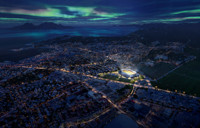
2024 © Nordic Office of Architecture 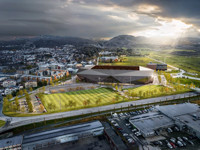
2024 © Nordic Office of Architecture 
2024 © Nordic Office of Architecture 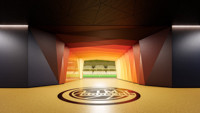
2024 © Nordic Office of Architecture 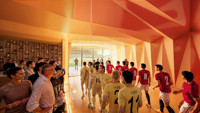
2024 © Nordic Office of Architecture 
2024 © Nordic Office of Architecture

 StadiumDB
StadiumDB